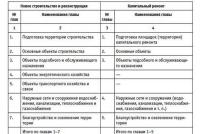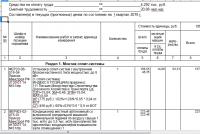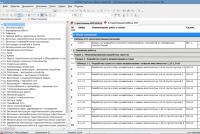How to spend a sick leave in a zup. Required settings for registering absence for an unexplained reason
Any of our colleagues knows very well that even in the "smallest" team, sooner or later there may be a need for sick leave payments. The regulatory framework on this issue in 2017 changed more than once. There were active conversations about electronic sick leave, people asked questions, they say, is it necessary to contact them at all, if the director still “does not let you get sick”? In general, there was a lot of idle chatter, and people did not make payments from this.
Today we will tell you about how easy and convenient it is to calculate sick leave without going beyond our beloved . Step-by-step instruction at your service, dear readers!
What should be done?
First of all, you must visit the section on personnel. Select the desired value there and click on the button "All charges":
Then you need to click on the button "Create"... In the list that appears, select the line "Sick leave".

After that, a page opens where we will need to enter all the data about the employee.
Among them, information about Full name, reason for incapacity for work, the period for which the employee will be released from the performance of official duties, and you will also need to indicate the percentage of the salary that will be compensated to him... Next, click on the button "Change":

After that, a table will be displayed on the screen that will help you calculate the average earnings of an ailing employee exactly to a penny, so you definitely won't have to sit with a calculator.

What does the question mark mean, you ask? Everything is very simple. The service independently calculated the average "cost" of one working day, based on the data on the minimum wage. One of the key benefits in comparison with the "boxed" versions of the program is that all updates occur automatically at startup, excluding the "aging" of the information.
After we double-check all the values, you can print the document in case the inspection authorities require it. In any case, the calculation will be saved in the program.

Accordingly, if a person is sick, then a recalculation must be made wages... Go to "Accrual".

As a result, we get exactly the values \u200b\u200bthat should be.

Obviously, dear friends, the calculation and accrual of "sick leave" is a very simple task for the "" service. and enjoy all its benefits to the full!
We wish you good luck!
Sick leave is calculated from the certificate of incapacity for work provided by the employee. The amount of the allowance depends on the nature of the incapacity for work, as well as the length of service. Consider how the insurance experience affects the calculation of benefits:
- Less than 5 years -60% of the average earnings calculation;
- From 5 to 8 years old - 80% of the calculated average earnings;
- Over 8 years - 100% of the average earnings.
Sick leave is calculated based on the data on the average earnings of the insured employee for the two previous years. At the same time, the calendar years for which the sick leave is calculated for the employee can be changed. These are situations when an employee in one or two of these calendar years used maternity leave or. According to the employee's application, one or both years are replaced if the replacement entails an increase in the amount of the benefit.
How to issue a sick leave in 1C 8.3 ZUP
Let's consider step by step how to conduct sick leave in 1C ZUP.
How to register a failure to appear on sick leave
If at the time of calculating the advance or salary, the employee is absent, then in 1C 8.3 ZUP it is necessary to register a failure to appear for an unexplained reason, so that salaries are not charged for the period of absence.
To be able to register the absence of an employee, you need to check the settings of the 1C program. Menu item Settings - select Payroll - then Configure the composition of charges and deductions - then Accounting for absences - Absenteeism and absenteeism checkbox:
No-show is registered with the help of the document Absenteeism, no-show. The document can be entered both in the personnel menu and in the Salary section:

From our example, an employee got sick in April from 11 to 22:

For each month of no-show / absenteeism, if no-show continues at next month, it is necessary to enter in 1C new document, that is, separately for May, for June, etc.
How to reflect a sick leave in 1C
After providing hospital employee, we make the document Sick leave for the calculation of benefits. The document is a personnel accounting document. It can be entered from the Frames section:

or using the Payroll section:

Create a new document. If the experience was not previously filled, then the program will pay attention to this fact:

If you go to this field, you can indicate the length of service immediately in the document:

We indicate the nature of the incapacity for work from the sick leave and the date of our sick leave. The month of accrual in our case is May, that is, this is the month that will be displayed on the employee's payroll. Checking the payment:

We check the accrual for sick leave:

A no-show for an unexplained reason is reversed on the Past Allocation tab page:

The sick leave payment date is important for recording personal income tax. Non-salary income is accounted for by the date of payment. You can choose the payment method - with an advance payment, with a salary, or inter-settlement. We carry out sick leave:

Calculation of sick leave payment in 1C 8.3 ZUP
Payment for sick leave for child care
The peculiarity of these sick leave is that payment for outpatient treatment is carried out in the first 10 calendar days in accordance with the length of service, and then in the amount of 50% of the average earnings. If the treatment takes place in a hospital, then taking into account the insurance experience.
There are also features of the calculation in 1C ZUP, depending on the age of the child. Selecting the option for calculating sick leave for care in the Sick leave document on the Childcare tab:

The 1C 8.3 ZUP program also tracks from what day the payment will take place in the amount of 50%:

Payment for sick leave for pregnancy and childbirth, for injury at work or occupational disease
If we pay for maternity leave, work injury or occupational disease benefit, then this is 100% sick leave payment and excluding length of service:

Also, if a dismissed employee has provided a certificate of incapacity for work within 30 calendar days from the date of dismissal, and has not yet found a new job, then this is payment in the amount of 60% of the calculated average earnings.
Calculation of average earnings
In 1C ZUP, when calculating the average earnings of an employee, taking into account earnings from previous policyholders it is necessary that the checkbox "Take into account the earnings of previous policyholders" was checked in the document:

Where in 1C ZUP 8.3 make earnings from previous policyholders? You need to go to the Main tab and click on the Change the calculation of average earnings button to fill in the data:

Or from the Salary section - See also - Help for calculating benefits:

Average earnings is determined by the 1C ZUP 3.1 program automatically based on the data on how much was included in the final base for calculating contributions to previous years... Average earnings are determined for each calendar year in an amount not exceeding the maximum size of the base for calculating insurance contributions to the Social Insurance Fund established for that year.
The average daily income for calculating benefits is calculated by dividing the accrued earnings by 730. For maternity benefits, earnings are divided by the sum of the calendar days of the previous two years minus the periods excluded (sick leave, parental leave, maternity leave, periods of leave from work with full or partial salary retention, if no insurance premiums were paid to the salary at that time).
You can see the printed form of the calculation. The printed forms Calculation of average earnings and Detailed calculation are used by the accountant to check the calculation and data, and the Calculation of benefits to the certificate of incapacity for work is an "official" calculation, we attach it to the sick leave:

Sick leave payment at the expense of the FSS
Funding for sick leave benefits depends on the nature of the disability. If this is a disease or injury (except for work), then the first three days are paid by the insured. Subsequent days are paid by the FSS. In other cases, payment is made at the expense of the FSS from the first day. In the 1C ZUP program, this division is visible in two types of sick leave calculation and sick pay at the expense of the employer:

Sick leave is calculated from the certificate of incapacity for work provided by the employee. The amount of the allowance depends on the nature of the incapacity for work, as well as the length of service. Consider how the insurance experience affects the calculation of benefits:
- Less than 5 years -60% of the average earnings calculation;
- From 5 to 8 years old - 80% of the calculated average earnings;
- Over 8 years - 100% of the average earnings.
Sick leave is calculated based on the data on the average earnings of the insured employee for the two previous years. At the same time, the calendar years for which the sick leave is calculated for the employee can be changed. These are situations when an employee in one or two of these calendar years used maternity leave or. According to the employee's application, one or both years are replaced if the replacement entails an increase in the amount of the benefit.
How to issue a sick leave in 1C 8.3 ZUP
Let's consider step by step how to carry out a sick leave in 1C ZUP.
How to register a failure to appear on sick leave
If at the time of calculating the advance or salary, the employee is absent, then in 1C 8.3 ZUP it is necessary to register a failure to appear for an unexplained reason, so that salaries are not charged for the period of absence.
To be able to register the absence of an employee, you need to check the settings of the 1C program. Menu item Settings - select Payroll - then Configure the composition of charges and deductions - then Accounting for absences - Absenteeism and absenteeism checkbox:
No-show is registered with the help of the document Absenteeism, no-show. The document can be entered both in the personnel menu and in the Salary section:

From our example, an employee got sick in April from 11 to 22:

For each month of no-show / absenteeism, if no-show continues in the next month, it is necessary to enter a new document in 1C, that is, separately for May, for June, etc.
How to reflect a sick leave in 1C
After providing the sick leave by the employee, we enter the sick leave document for calculating the benefit. The document is a personnel calculation. It can be entered from the Frames section:

or using the Payroll section:

Create a new document. If the experience was not previously filled, then the program will pay attention to this fact:

If you go to this field, you can indicate the length of service immediately in the document:

We indicate the nature of the incapacity for work from the sick leave and the date of our sick leave. The month of accrual in our case is May, that is, this is the month that will be displayed on the employee's payroll. Checking the payment:

We check the accrual for sick leave:

A no-show for an unexplained reason is reversed on the Past Allocation tab page:

The sick leave payment date is important for recording personal income tax. Non-salary income is accounted for by the date of payment. You can choose the payment method - with an advance payment, with a salary, or inter-settlement. We carry out sick leave:

Calculation of sick leave payment in 1C 8.3 ZUP
Payment for sick leave for child care
The peculiarity of these sick leave is that payment for outpatient treatment is carried out in the first 10 calendar days in accordance with the length of service, and then in the amount of 50% of the average earnings. If the treatment takes place in a hospital, then taking into account the insurance experience.
There are also features of the calculation in 1C ZUP, depending on the age of the child. Selecting the option for calculating sick leave for care in the Sick leave document on the Childcare tab:

The 1C 8.3 ZUP program also tracks from what day the payment will take place in the amount of 50%:

Payment for sick leave for pregnancy and childbirth, for injury at work or occupational disease
If we pay for maternity leave, work injury or occupational disease benefit, then this is 100% sick leave payment and excluding length of service:

Also, if a dismissed employee has provided a certificate of incapacity for work within 30 calendar days from the date of dismissal, and has not yet found a new job, then this is payment in the amount of 60% of the calculated average earnings.
Calculation of average earnings
In 1C ZUP, when calculating the average earnings of an employee, taking into account earnings from previous policyholders, it is necessary that the checkbox "Take into account the earnings of previous policyholders" is checked in the document:

Where in 1C ZUP 8.3 make earnings from previous policyholders? You need to go to the Main tab and click on the Change the calculation of average earnings button to fill in the data:

Or from the Salary section - See also - Help for calculating benefits:

Average earnings are determined by the 1C ZUP 3.1 program automatically based on the data on how much was included in the final base for calculating contributions in previous years. Average earnings are determined for each calendar year in an amount not exceeding the maximum base size for calculating insurance contributions to the Social Insurance Fund established for that year.
The average daily income for calculating benefits is calculated by dividing the accrued earnings by 730. For maternity benefits, earnings are divided by the sum of the calendar days of the previous two years minus the periods excluded (sick leave, parental leave, maternity leave, periods of leave from work with full or partial salary retention, if no insurance premiums were paid to the salary at that time).
You can see the printed form of the calculation. The printed forms Calculation of average earnings and Detailed calculation are used by the accountant to check the calculation and data, and the Calculation of benefits to the certificate of incapacity for work is an "official" calculation, we attach it to the sick leave:

Sick leave payment at the expense of the FSS
Funding for sick leave benefits depends on the nature of the disability. If this is a disease or injury (except for work), then the first three days are paid by the insured. Subsequent days are paid by the FSS. In other cases, payment is made at the expense of the FSS from the first day. In the 1C ZUP program, this division is visible in two types of sick leave calculation and sick pay at the expense of the employer:

Consider the charge on sick leave in 1C 8.3. Create a new document. We indicate the reason for the incapacity for work by choosing from the list:
The percentage of payment based on the experience, the 1C 8.3 program calculates from the data that is in the database. Enter information about work experience from the last place of work while there is no possibility in the configuration, the percentage of payment can be corrected manually:

In the program 1C 8.3 Accounting, you can view and edit, if necessary, the calculation of average earnings. To do this, click on the pencil:

Also in the configuration of 1C Accounting 8.3, it is possible to replace the estimated years. If we change the year, then it is important not to forget to recalculate the benefit:

Information for calculating the average can be viewed as a summary by year or by month. If any data needs to be corrected, then this can be done in the form:

From the document, you can print the calculation of the average earnings:

Calculation of average earnings in 1C 8.3:

On the Additional tab, you can specify the limitation of benefits, if any. And also the application of benefits by choosing from the list:

On the Accrued tab, we see the calculation of sick leave: three days at the expense of the employer and the rest at the expense of the FSS:

Pay attention to the date of payment:

With the help of the Sick leave document, you can not only calculate the payment of benefits. Program 1C 8.3 Accounting calculates the salary, taking into account the absence of an employee:

How to carry out a sick leave in 1C 8.3 Accounting (3.0), how to correctly calculate sick leave is discussed in the module. For more information about the course, see our video:
Rate this article:
Sick leave certificates in the 1C 8.3 ZUP program are registered to calculate disability benefits. The data from the sick leave are entered into the program, and the sick leave is automatically calculated taking into account the employee's length of service and his income for previous periods. Read more about calculating sick leave in 1C ZUP 8.3 in this article.
Read in the article:
A sick leave is issued to an employee in medical institution... This document confirms the legality of the release from work and is necessary for the calculation of various benefits. The reasons for release can be different - illness or injury, maternity leave, caring for a sick child, etc. Based on the sick leave, the accountant calculates various benefits.
Read how to carry out a sick leave in 1C 8.3 ZUP in 4 steps.
Step 1. Open the "Sick lists" window
Go to the section "Salary" (1) and click on the link "Sick lists" (2). A new window will open.
In the window that opens, you will see a list of sick leaves. To register a new sick leave in ZUP 1C 8.3, click the "Create" button (3).

An additional window "Sick leave (create)" will open for entering the data that are required when calculating sick leave benefits. It looks like this:

Step 2. Fill in the basic details
In the upper section of the "Sick leave (creation)" window, fill in the "Organization" field (4), indicate the month in which the benefit will be calculated (5), and select the employee for whom the sick leave is filled in (6). Also enter in the field "LN number" (7) the number of the sick leave issued by the medical institution.

Step 3. Fill in the data for calculating sick leave
In the "Main" tab (8), select the reason for the incapacity for work (9) and indicate the period of leave from work (10). Below, in the "Payment" window (11), indicate when you will issue disability benefits: with an advance payment, salary, or in between. Now, in the fields "Accrued" and "Withheld", you see the amount of accrual and deduction for sick leave.

In the "Payment" tab of the sick leave in 1C 8.3 ZUP (12), you can see what percentage of wages is taken into account when calculating sick leave (13). Here you can see the work experience (14), from which this percentage is calculated. If the data on the experience is entered in 1C 8.3 ZUP correctly, then the program automatically determines the percentage of payment. We remind you that if the employee's work experience is 8 years or more, then when calculating the sick leave, 100% of the average earnings are taken into account, if the work experience is from 5 to 8 years - 80%, up to 5 years - 60%.

In the tab "Assessed (in detail)" (15) in the sick leave in 1C ZUP 8.3, you can see separately the accruals at the expense of the employer (16) and at the expense of the Social Insurance Fund (17). Here you will also see the number of days paid by the employer (18) and by the FSS (19). As you remember, the first three days of sick leave issued due to illness or injury are paid by the employer, and from the 4th day such sick leave is paid by the FSS.






